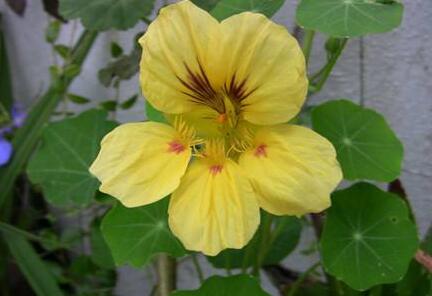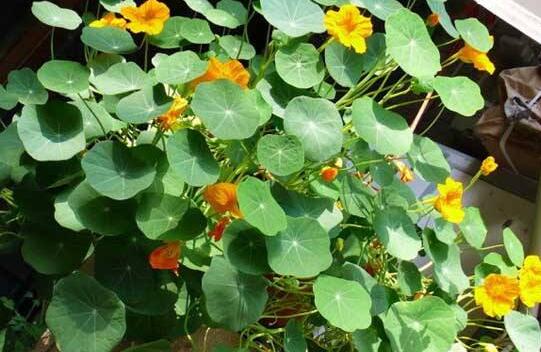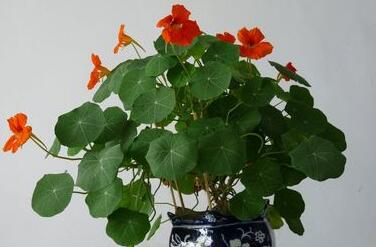How to apply fertilizer and what fertilizer / nitrogen, phosphorus and potassium nutrition balance can be used in Golden Lotus?
Golden lotus is a favorite flowering plant for many people. Fertilization is a very important point in its growth process, which is related to whether the flower color is gorgeous, whether the number of flowers can be more, and so on. What kind of fertilizer can dry lotus use? The following editor will tell you the answer.
What kind of fertilizer can be used for dry lotus?
1. Base fertilizer

For the soil used to cultivate trollius, it is best to add some base fertilizer before going to the pot. if livestock manure is used as base fertilizer, it can be applied at the bottom of the basin, and if compound fertilizer is used as base fertilizer, it can be mixed in the soil, which is generally 1/10 of the soil.
2. Bean cake water
In March to October, generally need to apply bean cake water, it should be noted that it must be rotten bean cake water. In addition, the more suitable fertilizer is calcium phosphate, which can promote the growth of branches and leaves. In addition, nitrogen fertilizer is also essential, which can ensure that the leaves are greener.
How to apply fertilizer to Clematis paniculata
1. When planting in pots
When transplanting or potting the lotus, we need to use base fertilizer, which can improve the soil nutrients and make the soil more fertile, which is very good for long-term planting. The soil with base fertilizer can be changed every 2-3 years, while the ordinary soil needs to be changed every 1-2 years.
2. Growth period
In order to make the lotus blossom smoothly during the flowering period, it is generally necessary to apply mature bean cake water once a month during the growing period, with a concentration of 20%. It must be noted that the concentration is not too high, otherwise the branches and leaves may be burned to death, and the loss outweighs the gain.
3. During flowering
One of the functions and functions of Clematis is to watch flowers, so the maintenance and management of flowering is very important. if you want to make the florescence last longer, you need to stop applying nitrogen fertilizer after flowering, but use 0.5% calcium phosphate once every 15 days. it can take longer to watch the flowers.
4. After the flowers fade
After the flowers wither, the lotus also needs a certain amount of fertilizer, generally need to apply a mature bean cake water, and then wait for it to resume growth, and then start fertilizing in accordance with the normal growth period.
Matters needing attention in fertilization of Clematis paniculata
In summer, if the temperature is relatively high, you need to stop fertilizing, such as when the temperature is higher than 30 degrees, or it is easy to burn the plant to death. When autumn is about to enter winter, it is best to apply a compound fertilizer to improve its ability to resist the cold.
How to raise Anoplophora acuminata? breeding methods and precautions / sufficient light should be needed.
Among the plants that can observe both leaves and flowers, it is relatively easy to breed. It is not only easy to raise, but also has many effects and functions, so it is very popular, but it still needs to master some skills before breeding. So how to raise it? Let's take a look at the breeding methods and points for attention of Clematis paniculata.
How to raise dry golden lotus
It likes a warm climate, cold and heat resistance is general, the temperature should be kept above 10 degrees and below 35 degrees, otherwise its growth will be restrained, it needs more adequate light in other seasons except summer, and avoid strong light exposure in the middle of summer.
Culture methods and matters needing attention of Clematis paniculata
I. Culture methods
1. Soil
The most suitable soil is the sandy soil rich in humus, the PH value is between 5 and 6, and pay attention to the good drainage of the soil, which can be loosened to ensure the air permeability of the soil, which is beneficial to the growth and development of the root system.
2. Temperature
In the breeding methods and matters needing attention, the suitable growth temperature is 18-24 degrees, while the suitable temperature for germination when sowing and breeding is 18-20 degrees, the temperature should be kept above 10 degrees in winter and below 35 degrees in summer, otherwise it will be difficult to blossom.
3. Lighting
Clematis is a plant that is relatively easy to bloom, but it needs more light during the growing period. It can be maintained in the sun in spring, autumn and winter, but it should be protected from shade in summer to avoid excessive temperature caused by sun exposure. to affect its flowering.
4. Fertilizer and water
Fertilizer and water is very important for dry golden lotus, so how to raise it in this respect? It is usually watered every 2-3 days in spring and autumn, and can be watered once a day in summer, and can be sprayed if the temperature is high. It is necessary to reduce watering during the flowering period to avoid the steep growth of branches. Compound fertilizer is the main fertilizer to ensure the balance of nitrogen, phosphorus and potassium.
5. Reproduction
Under normal circumstances, Golden Lotus will be propagated by cutting or sowing. Sowing can be done in spring, from March to June, or in autumn. Spring is more suitable for cutting. In addition, it can also be pollinated by self-pollination, so the seeds are easier to collect.
II. Points for attention
1. During the rainy season and watering, you should be careful not to accumulate water. Golden lotus likes to be moist but afraid of waterlogging. The moisture in the soil is only 50% lard. If you water too much, the roots are easy to rot, and it is easy to cause leaves to wither and yellow. All usually watering is mainly watered with small water.
2. Try to keep it in a cool place in summer, because the high temperature will affect its flowering and may even cause it not to blossom. After it begins to cool down in October, it needs to be placed in a sunny place to ensure that the temperature is 10-15 degrees Celsius to make it through the winter smoothly.
3. Because the lotus is a semi-trailing plant, if you want to control its growth, it will generally be guided by a bracket, otherwise it will affect the ornamental. When the branches are too long, pruning can be used to control the overall plant shape.
It's so cold outside, but these plants at home are in full bloom.
At the beginning of the new week, strong cold air is spreading across the country, where the cold wave passes, the temperature plummets 12-14 ℃, and many cities join the snowfall. In the cold weather, most plants go into dormancy. The gorgeous flowers in full bloom at this time are undoubtedly the "spiritual candles" in the cold winter, which can exhilarate people's spirits and nourish their body and mind.
Just now, raise these flowers, or choose to come back into a good care, when it is cold, the winter room will be full of flowers and fragrance.
01
African chrysanthemum
▼
The color of African chrysanthemum is extremely brilliant, which always brings people the vitality of the sun, so it is also called sunflower. In the cold weather of rain and snow, such flowering plants are often planted at home, which is sure to keep the sun in your heart.
Flowering: it may bloom all the year round. In order to blossom vigorously in winter, some buds can be removed appropriately in summer to retain nutrients, and the flowers will bloom more vigorously in November and December.
Room temperature management: the suitable temperature for African chrysanthemum flowering is 15-30 ℃, which blossoms continuously, and the plant stops growing when the temperature drops below 7 ℃, so it is necessary to maintain a certain indoor temperature.
Lighting: gerbera is good for light as much as possible. Put the plant on the eastward closed balcony in winter, strive for more than 4 hours of light every day, and make up with artificial light in overcast and rainy weather.
Fertilizer and water management: the principle of African chrysanthemum watering is not dry and not watered. When the leaves are slightly soft, they can water the basin soil at once. When watering, we should pay attention to the fat water to avoid the heart of leaves and buds, so as to avoid bad heart.
The fertilization of African chrysanthemum should be adequate and balanced. If you want to grow strong, you should use balanced fertilizer of nitrogen, phosphorus and potassium, but not too much nitrogen fertilizer, otherwise the leaves will be thick and affect the development of flower buds. High phosphorus and potassium fertilizer is used to promote flowering at flowering stage.
02
Cyclamen
▼
Cyclamen needs sunshade and dormancy in summer and begins to bloom in winter. It has bright colors and can make the room look beautiful. Moreover, some varieties of cyclamen will have a strong aroma, full of fragrance.
Flowering: it begins to bloom in November every year, but it can bloom until May of the following year.
Room temperature management: cyclamen likes warmth, is afraid of heat, is more resistant to cold, and can withstand the low temperature of 0 ℃. The suitable growth temperature in winter is between 12 ℃ and 16 ℃, and the promotion of flowering should not exceed 18 ℃. Summer goes into semi-dormancy.
Illumination: October to next spring is the growing period of cyclamen, and it should be provided with a sunny environment at this time. The indoor air keeps a high humidity.
Fertilizer and water management: control watering and no fertilization during summer dormancy. If the growth is restored after autumn, the amount of water can be gradually increased and thin fertilizer can be applied. Fertilize 2-3 times a month.
03
Longevity flower
▼
The name of the longevity flower is beautiful, and the flower is also beautiful. The variety of longevity flowers is diverse and colorful, which embellishes the winter home with great vitality.
Flowering: it begins to bloom in December and may blossom in May next year.
Room temperature management: the most suitable temperature for growth is 15 ℃ to 25 ℃, growth stagnation below 10 ℃, redness of leaf color below 8 ℃, delayed flowering, and easy to freeze to death below 0 ℃.
Lighting: longevity flowers like a sunny environment, except for a little shade at midsummer, the rest of the time should be placed in the sun, at least 4 hours of direct light can be seen every day in order to grow healthily.
▲ nymphomaniac old lady Aunt Liu's longevity flowers
Fertilizer and water management: it is more resistant to drought but afraid of waterlogging. It can be watered once after seeing the basin soil dry in about 3 days in autumn and keep it slightly moist. After entering the house in winter, it is appropriate to use water similar to room temperature at noon, about once a week. It is advisable to apply thin N, P and K fertilizer once a month during flowering.
04
Calendula
▼
Calendula is often used as raw material for skin care products, and it is also one of the raw materials for common herbal tea. It blossoms when the flower wheel is very beautiful, the color is mainly golden yellow and golden orange, it is also the gorgeous flower in winter.
Flowering: in full bloom from December to June, cut off the branches with old and yellow leaves every two months, as long as the temperature is suitable, it can blossom all the year round.
Room temperature management: like sunny environment, strong adaptability, ability to-9 ℃ low temperature, afraid of hot weather, room temperature should not be higher than 25 ℃.
Lighting: when the winter temperature is not very high, let it accept direct sunlight, which is conducive to its growth and photosynthesis.
Fertilizer and water management: when it is kept indoors, it is usually watered every 6 days, with shorter intervals in sunny days or high temperatures, longer intervals in rainy days or low temperatures, or no watering. Apply light fertilizer twice a week.
05
Clematis paniculata
▼
Trollius is a common indoor flower. When the flowers are in bloom, dozens of flowers can bloom in a pot, which smells sweet and beautiful, and warms the hearts of the people in winter.
Flowering period: under the condition of proper maintenance and suitable environment, it can blossom all the year round, and it is also a good time to bloom now. New Year's Day, common flowers during the Spring Festival.
Room temperature management: like a mild climate, the temperature suitable for growth is 18 Mel 24 ℃. Can bear short-term 0 ℃ like warm and humid, overwintering temperature above 10 ℃.
Lighting: when the temperature is low in autumn and winter, you need enough light, which is suitable for the corner where you can see the sun in your home.
Fertilizer and water management: generally watering once every other day after entering autumn, the watering times of flower buds should be reduced appropriately, but the amount of water should be increased each time to make the basin soil dry and wet. A compound overwintering fertilizer should be applied at the end of autumn to enhance the cold resistance of the plant.
In addition to the above five kinds of indoor flowers in winter, Xiaoli, Fusang and Milan also blossom all the year round if they are well raised. Petunia can be sown by stages and can also see flowers throughout the year. Although it is the tail of the chrysanthemum florescence at present, many seasonal varieties of chrysanthemum are blooming, and they are the most dazzling plants in the world where everything begins to hibernate.
Back home from the cold outdoors, to see such bright flowers will make people sigh: life is really beautiful. Flowers not only decorate the home, but also bring vitality and sunshine!
- Prev

How to raise dry lotus in summer, how to grow stout / cooling and shading
In the cultivation method of Clematis paniculata, because of its fear of high temperature, it must pay attention to the changes of temperature and humidity in summer, otherwise it is easy to produce yellow leaves, plant wilt and even death, so how to raise it in summer? How does the dry lotus grow stout? Maintenance skills in summer together
- Next

How to change the pot and transplant, time and soil are very important / maintenance skills after transplanting
Because of its fast growth rate, it is relatively easy to burst the pot, so it needs to change the flowerpot and soil after a period of time, and because it needs to adapt to the new potted soil environment after changing the pot, in order to ensure that it can pass this period of time smoothly, you need some skills when transplanting.
Related
- Fuxing push coffee new agricultural production and marketing class: lack of small-scale processing plants
- Jujube rice field leisure farm deep ploughing Yilan for five years to create a space for organic food and play
- Nongyu Farm-A trial of organic papaya for brave women with advanced technology
- Four points for attention in the prevention and control of diseases and insect pests of edible fungi
- How to add nutrient solution to Edible Fungi
- Is there any good way to control edible fungus mites?
- Open Inoculation Technology of Edible Fungi
- Is there any clever way to use fertilizer for edible fungus in winter?
- What agents are used to kill the pathogens of edible fungi in the mushroom shed?
- Rapid drying of Edible Fungi

